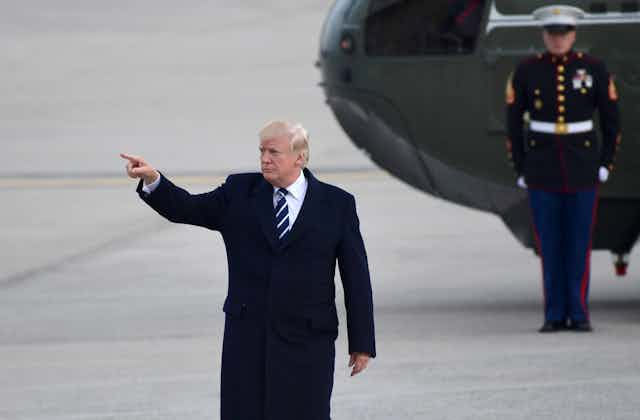The main objective of international trade agreements like NAFTA is to put limits on the ability of politicians to intervene in trade matters — for example, mutually agreeing to remove tariffs on certain goods and never raising them in the future.
This ensures that society benefits from trade by increasing the predictability and reducing the risks for companies wishing to engage in international commerce.
In the past, when politicians were unconstrained — when there were no rules of trade — the result was economically damaging, beggar-thy-neighbour trade wars.
A system of rules for trade has been in place since 1947, with the successful negotiation of the multilateral General Agreement on Tariffs and Trade (GATT). NAFTA fits within that rules-based system.
Over the 70-year span since the GATT rules were established, politicians have generally accepted the constraints on their actions that have been agreed upon — often by the elected officials who preceded them.
U.S. President Donald Trump, of course, is not cut from that cloth. He does not accept that there should be constraints on his freedom to act as he sees fit.
Trump faces limits
This is not only manifest in the sphere of international trade, but also more broadly. He rails against constraints, but nonetheless the courts have limited his ability to ban travellers from certain countries, and the United States Congress has so far denied him the funds to build a wall on the Mexican border.
When Trump refers to existing trade deals as being bad deals for the U.S. or the worst deal ever, he is not really speaking about specific trade policies. Rather, he’s complaining that previous administrations have agreed to provisions that hem him in.
In an attempt to exert his ability to act as he sees fit, Trump recently chose to hike tariffs to punish countries he accuses of trading unfairly because they’re running trade surpluses with the U.S. or have been able to induce firms to move production, and jobs, out of the United States.
As an expert on agri-food trade who has advised on trade agreements since the pre-NAFTA Canada-U.S. Trade Agreement (CUSTA) negotiations, I believe the Trump administration forced, under threat of cancellation, the renegotiation of NAFTA — primarily to remove constraints on his freedom to act in trade matters concerning Mexico and Canada.
Agriculture not a big U.S. target
The U.S. had no specific agricultural agenda in its desire to alter NAFTA. But if the renegotiations result in removing protections for Canada’s agri-food sector, then the risk for Canadian firms exporting farm products to the United States would likely increase considerably.
How?
The U.S. has put two major proposals on the table: To remove the NAFTA dispute settlement mechanism, and to have the new agreement subject to a cancellation review every five years.
Read more: The big challenge of the NAFTA renegotiations: dispute settlement
Removal of the NAFTA dispute settlement mechanism would, in effect, remove any constraint on the use of anti-dumping and unfair subsidy/countervailing duties by the United States.
It’s well known that the domestic institutions that carry out investigations into the types of trade disputes arising from anti-dumping and countervail actions can lead to biased results, but the bias is kept somewhat in check by NAFTA’s dispute settlement system.

The beef and pork industries in Canada are well-acquainted with the risks and costs associated with U.S. anti-dumping and countervail actions. Other U.S. policies such as country-of-origin labelling have been moderated by the constraints inherent in dispute settlement mechanisms.
Absent NAFTA, Canada would still have access to the World Trade Organization (WTO) dispute settlement system, but U.S. officials are attempting to remove that constraint as well.
Why locate in Canada?
Having a cancellation review every five years would also make it risky to locate any processing facilities designed to serve the North American market in Canada.
Because most processing facilities have lifespans much longer than five years, it would be much safer for a company to locate a plant in the U.S. in the event NAFTA were to be cancelled in the near future .
It is fairly clear that the decision to locate major beef processing facilities in Western Canada was based on the secure market access provided by the original CUSTA. If that secure access is lost, similar investment in Canada could not be expected.
There is one specific agricultural issue in the NAFTA renegotiation.
The U.S. has asked for better access to Canadian dairy markets. Canada’s supply management system limits imports on milk, a range of dairy products such as cheese and ice cream as well as poultry. NAFTA has removed tariffs on most products with the glaring exception of those covered by supply management.
It’s an obvious and easy target for the Americans.
Canadian governments of all political stripes have been tenacious in defending the trade barriers needed to bolster supply management — through GATT, CUSTA, NAFTA, WTO, CETA and TPP negotiations.
Given that agriculture is not a focus of the Trump administration, small concessions might be expected on dairy and poultry.
What’s ahead?
If the NAFTA negotiations fail and the Trump administration decides to withdraw from the deal, it’s not clear whether U.S.-Canada trade relations will revert to CUSTA, with little change from NAFTA, or to the WTO.
If it’s the WTO, there would be higher tariffs on some agricultural products destined for the United States.
The Canadian government is between a rock and a hard place in the NAFTA negotiations — if they accept U.S. demands on dispute settlement and five-year reviews, then many of the benefits of NAFTA would be nullified.
If they do not agree, the Trump administration may withdraw from NAFTA.
For now, the best option is to keep everyone at the negotiating table and hope that Trump finally accepts some constraints on his behaviour.

